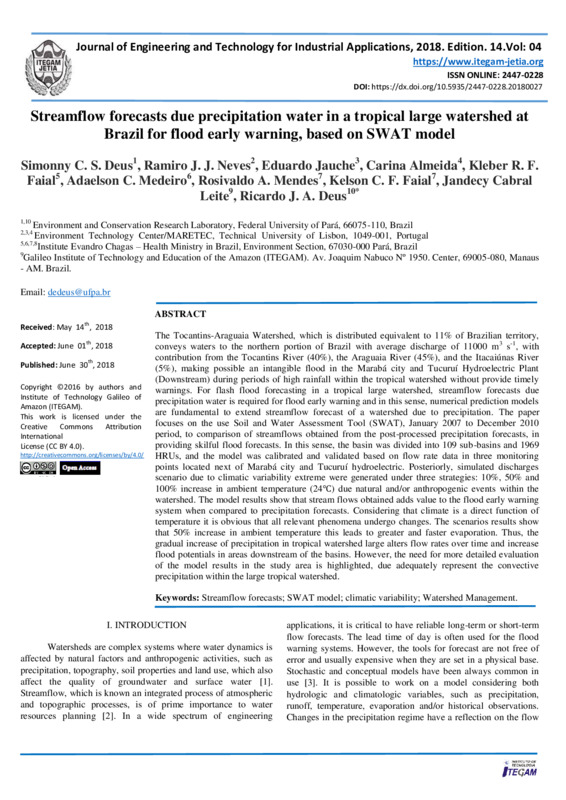-
Tipo do ITEM
-
Artigo Ciêntifico
-
Título do Artigo
-
Streamflow forecasts due precipitation water in a tropical large watershed at Brazil for flood early warning, based on SWAT model
-
Descrição
-
The Tocantins-Araguaia Watershed, which is distributed equivalent to 11% of Brazilian territory,
conveys waters to the northern portion of Brazil with average discharge of 11000 m3
s
-1
, with
contribution from the Tocantins River (40%), the Araguaia River (45%), and the Itacaiúnas River
(5%), making possible an intangible flood in the Marabá city and Tucuruí Hydroelectric Plant
(Downstream) during periods of high rainfall within the tropical watershed without provide timely
warnings. For flash flood forecasting in a tropical large watershed, streamflow forecasts due
precipitation water is required for flood early warning and in this sense, numerical prediction models
are fundamental to extend streamflow forecast of a watershed due to precipitation. The paper
focuses on the use Soil and Water Assessment Tool (SWAT), January 2007 to December 2010
period, to comparison of streamflows obtained from the post-processed precipitation forecasts, in
providing skilful flood forecasts. In this sense, the basin was divided into 109 sub-basins and 1969
HRUs, and the model was calibrated and validated based on flow rate data in three monitoring
points located next of Marabá city and Tucuruí hydroelectric. Posteriorly, simulated discharges
scenario due to climatic variability extreme were generated under three strategies: 10%, 50% and
100% increase in ambient temperature (24℃) due natural and/or anthropogenic events within the
watershed. The model results show that stream flows obtained adds value to the flood early warning
system when compared to precipitation forecasts. Considering that climate is a direct function of
temperature it is obvious that all relevant phenomena undergo changes. The scenarios results show
that 50% increase in ambient temperature this leads to greater and faster evaporation. Thus, the
gradual increase of precipitation in tropical watershed large alters flow rates over time and increase
flood potentials in areas downstream of the basins. However, the need for more detailed evaluation
of the model results in the study area is highlighted, due adequately represent the convective
precipitation within the large tropical watershed.
-
Abstract
-
The Tocantins-Araguaia Watershed, which is distributed equivalent to 11% of Brazilian territory,
conveys waters to the northern portion of Brazil with average discharge of 11000 m3
s
-1
, with
contribution from the Tocantins River (40%), the Araguaia River (45%), and the Itacaiúnas River
(5%), making possible an intangible flood in the Marabá city and Tucuruí Hydroelectric Plant
(Downstream) during periods of high rainfall within the tropical watershed without provide timely
warnings. For flash flood forecasting in a tropical large watershed, streamflow forecasts due
precipitation water is required for flood early warning and in this sense, numerical prediction models
are fundamental to extend streamflow forecast of a watershed due to precipitation. The paper
focuses on the use Soil and Water Assessment Tool (SWAT), January 2007 to December 2010
period, to comparison of streamflows obtained from the post-processed precipitation forecasts, in
providing skilful flood forecasts. In this sense, the basin was divided into 109 sub-basins and 1969
HRUs, and the model was calibrated and validated based on flow rate data in three monitoring
points located next of Marabá city and Tucuruí hydroelectric. Posteriorly, simulated discharges
scenario due to climatic variability extreme were generated under three strategies: 10%, 50% and
100% increase in ambient temperature (24℃) due natural and/or anthropogenic events within the
watershed. The model results show that stream flows obtained adds value to the flood early warning
system when compared to precipitation forecasts. Considering that climate is a direct function of
temperature it is obvious that all relevant phenomena undergo changes. The scenarios results show
that 50% increase in ambient temperature this leads to greater and faster evaporation. Thus, the
gradual increase of precipitation in tropical watershed large alters flow rates over time and increase
flood potentials in areas downstream of the basins. However, the need for more detailed evaluation
of the model results in the study area is highlighted, due adequately represent the convective
precipitation within the large tropical watershed.
-
Língua do arquivo
-
inglês
-
Data da Publicação
-
Ano 2018
-
Palavra-chave
-
Streamflow forecasts
-
SWAT model
-
climatic variability
-
Watershed Management
-
Autores
-
Simonny C. S. Deus
-
Ramiro J. J. Neves
-
Eduardo Jauche
-
Carina Almeida
-
Kleber R. F. Faial
-
Adaelson C. Medeiro
-
Rosivaldo A. Mendes
-
Kelson C. F. Faial
-
Jandecy Cabral Leite
-
Ricardo J. A. Deus
-
Local
-
ITEGAM - Belém, 2018


